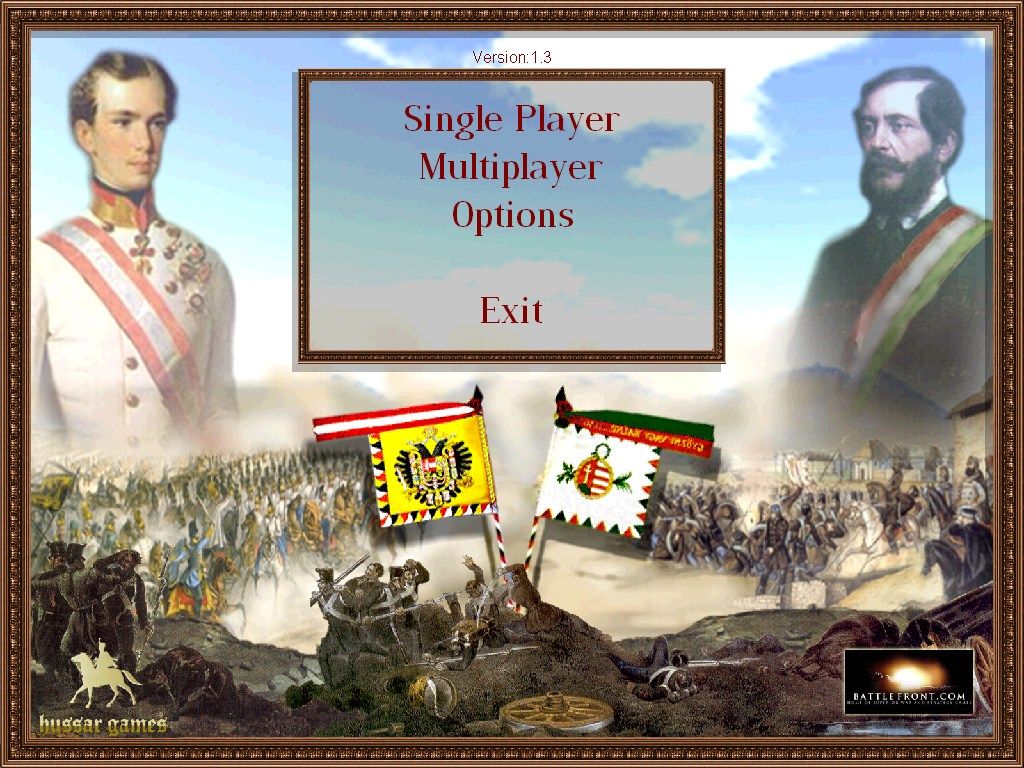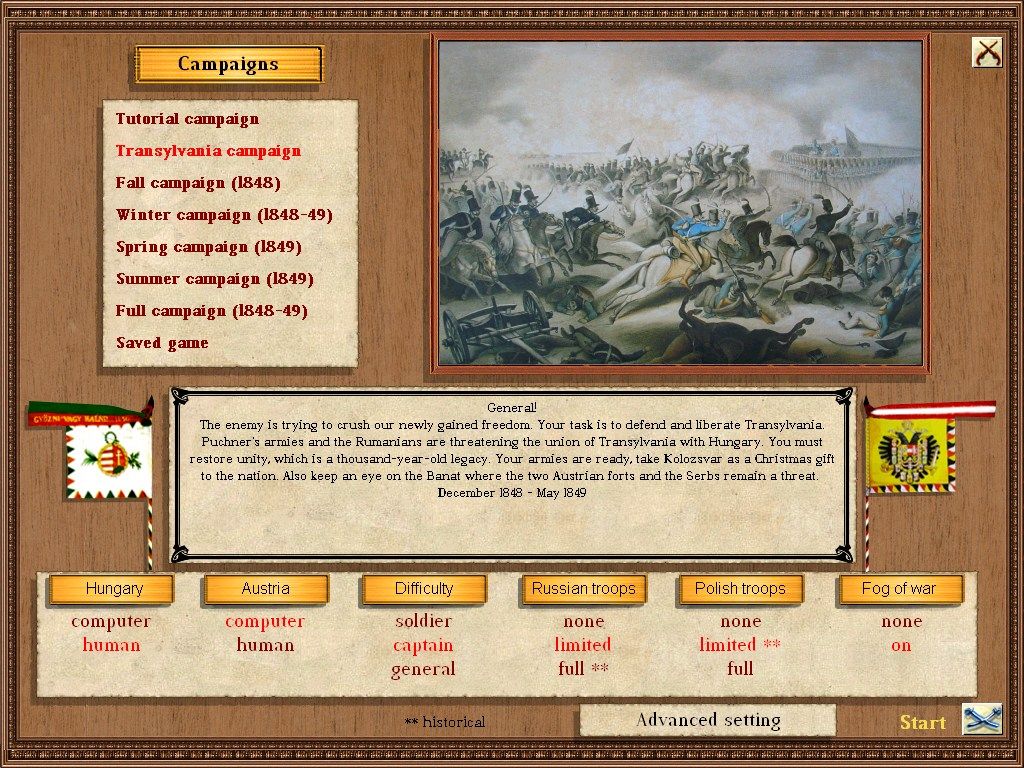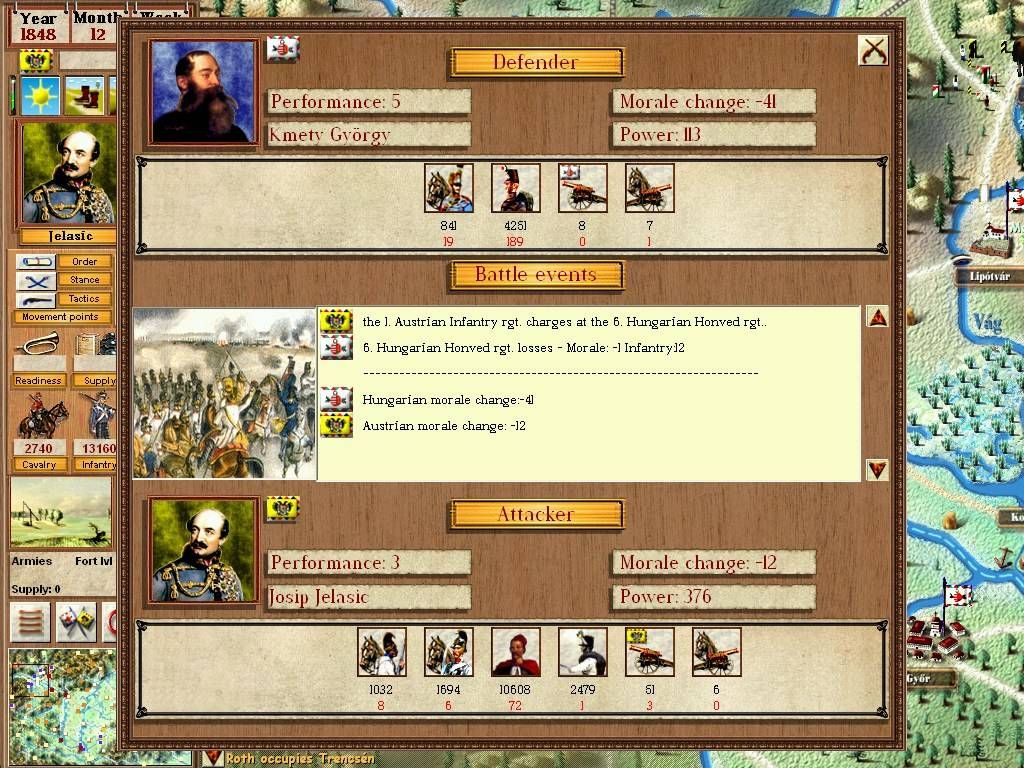Retro Replay Review
Gameplay
The heart of 1848 lies in its richly detailed hex-based strategic layer, where each turn represents a week of campaigning during the Hungarian Independence War of 1848–49. Players are given full control over their armies, issuing orders that range from basic maneuvers to highly nuanced battlefield preparations. The alternating turns reward careful planning, and every decision feels meaningful—whether you’re massing your cavalry for a decisive blow or reinforcing a threatened fortress.
(HEY YOU!! We hope you enjoy! We try not to run ads. So basically, this is a very expensive hobby running this site. Please consider joining us for updates, forums, and more. Network w/ us to make some cash or friends while retro gaming, and you can win some free retro games for posting. Okay, carry on 👍)
Depending on the selected difficulty, the game allows a varying number of actions per turn. You can set stances for your armies—choosing between defensive, balanced or aggressive postures—select specialized tactics, and even reorganize or split your forces at will. Beyond movement and combat, you’re tasked with a host of logistical challenges: recruiting fresh regiments, dispatching reconnaissance missions, repairing or besieging forts, and fortifying key supply points across the map.
Each regiment under your command—infantry, cavalry, or artillery—carries a suite of statistics to manage, such as morale, experience, readiness, supply and strength. Changing your commanding generals also plays a critical role, as each comes with unique attributes like initiative, attack, defense and specialized bonuses. Finding the right leader for a particular army can turn the tide of battle, especially when facing Austrian or Russian forces on multiple fronts.
When clashes do occur, the battles are resolved automatically by the game engine. Rather than focusing solely on casualty counts, 1848 simulates engagements based on shifts in army morale and the overall “zeal” of your revolutionary cause. Weather and terrain add extra layers of unpredictability, while towns and forts serve as vital supply hubs. This system keeps the flow of play smooth, freeing you to concentrate on the grand strategy without getting bogged down in minute tactical details.
Graphics
1848’s graphical presentation is unassuming yet functional, favoring clarity over flash. The hexagonal map tiles are rendered in muted earth tones, capturing the pastoral landscapes and fortified towns of mid-19th century Hungary. Unit counters are crisply depicted, with distinctive icons for infantry, cavalry and artillery that remain legible even when several armies converge in a single region.
The interface design—while reminiscent of classic wargames—strikes a balance between nostalgia and usability. Tooltips and pop-up windows convey critical information on unit stats, terrain effects and weather conditions without cluttering the screen. Though there are no elaborate 3D animations or cinematic cutscenes, the game’s minimalistic aesthetic lets you focus on the strategic map and your overarching campaign plans.
Weather and terrain effects are visually represented through subtle changes on the map: snow-covered hexes slow movement in winter, while rivers and forests influence combat outcomes with clear graphical cues. Fortified towns are marked by distinct icons, reminding players of their defensive importance. All in all, 1848’s graphics serve the gameplay admirably, reinforcing immersion without overshadowing the core wargaming experience.
Story
Set against the backdrop of the Hungarian Independence War of 1848–49, 1848 immerses you in a pivotal chapter of European history. Revolutions erupted across the continent, and Hungary’s courageous stand against the Austrian empire once held the promise of lasting freedom. Your role as commander allows you to shape this narrative—will you secure a historic victory or watch the revolutionary flame flicker out beneath the combined might of Austria and Tsarist Russia?
As the campaign unfolds, historical events—such as the arrival of Russian troops under Czar Nicholas I—emerge on the strategic map and force you to adapt your plans. Stalemate battles, guerrilla skirmishes and sieges of key fortresses all play into the broader story of revolution and counterrevolution. The game’s timeline and weekly turns give each decision a sense of urgency, as you race to seize momentum before reinforcements tip the balance against you.
Although 1848 does not feature narrated cutscenes or scripted character arcs, it weaves its narrative through dynamic events and battlefield outcomes. The global morale indicator, “zeal,” reflects the spirit of the Hungarian people and responds to your successes or failures. Each victory bolsters public confidence, while setbacks risk eroding the revolutionary fervor that sustains your cause. In this way, the story is both reactive and deeply tied to your actions on the grand strategic level.
Overall Experience
For fans of classic turn-based wargames, 1848 offers a gratifying blend of accessibility and depth. The learning curve is gentle enough for newcomers to hex-based strategy, yet veterans will appreciate the layers of nuance in army management, logistics and morale warfare. Every campaign feels like a fresh puzzle, with shifting priorities and emerging challenges that demand thoughtful adaptation.
The emphasis on historical authenticity adds gravitas to each decision. You’re not merely moving counters on a map; you’re re-enacting—or rewriting—a defining conflict in European history. The automatic battle resolution system keeps gameplay brisk, yet the outcome is never predetermined. Moments of tension arise when you must decide whether to risk a bold offensive or consolidate your forces for a protracted defense.
While some players might miss the visual spectacle of modern AAA titles, 1848’s classical presentation underscores its strategic focus. Its strengths lie in careful planning, resource management and the emotional stakes of leading an underdog rebellion. Whether you’re a history buff intrigued by the Revolutions of 1848 or a strategy enthusiast seeking a new challenge, 1848 delivers a memorable and thought-provoking wargaming experience.
 Retro Replay Retro Replay gaming reviews, news, emulation, geek stuff and more!
Retro Replay Retro Replay gaming reviews, news, emulation, geek stuff and more!







Reviews
There are no reviews yet.